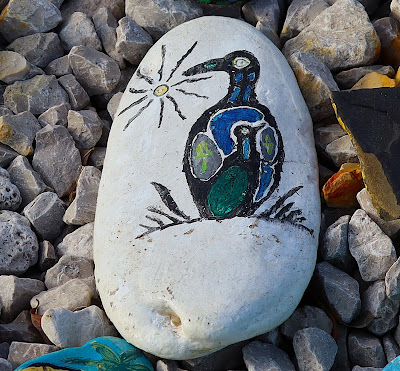A Very 'Birdy' New Year's Day!
Several birders headed to the waterfront to start a new birding list for 2025! We were lucky with the weather; cool but not frigid, and the sun even shone a bit! By the end of the second day of January, I had seen 63 species of birds...a good start for 2025!
The only circumpolar diving duck, the Greater Scaup, breeds across the tundra regions in both North American and Europe. Above, a female Greater Scaup bounces in the waves of the St. Clair River.
https://www.allaboutbirds.org/guide/greater_scaup/overview
Of all the diving ducks, Long-tailed Ducks, spend the most time underwater. During foraging excursions, they spend 3 or 4 times as long underwater as they do on the surface!
https://www.allaboutbirds.org/guide/Long-tailed_Duck/overview
The 'famous Rock Snake' along the St. Clair River at the Point Edward waterfront earned us an owl (species?) and Razorbill! 😏
The Swan Goose (Anser cygnoides) is a large goose with a natural breeding range in inland Mongolia, northernmost China, and the Russian Far East. While uncommon in the wild, this species has been domesticated. Introduced and feral populations of its domestic breeds occur in many places outside its natural range. (I have seen them in animal farms and on private farms. Perhaps we will get a local feral population in a few years??) They feed mainly on grasses, leaves, roots, sledges and water plants.
https://animalia.bio/swan-goose
Bufflehead dive for aquatic invertebrates, crustaceans and mollusks. They usually swallow their food while still underwater.
https://www.ducks.ca/species/bufflehead/
A Cruise Ship is docked in Chemical Valley. Cruise Ships pass through the St. Clair River, but I have never seen one in transit. This ship appears to need some maintenance.
Another domestic duck: Domestic Mallard
We learned from friends that a Pileated Woodpecker was at Camp Saredaca in the morning. Although we didn't visit until the afternoon, it made an appearance, flying back and forth searching for bugs in dead tree stands. Pileated Woodpeckers drum slowly, accelerating and them trailing off at the end which distinguishes them from most other woodpeckers that drum at a steady rate. They can drum close to 17 beats per second and will perform 10 to 30 beats before taking a break!
https://www.audubon.org/news/10-fun-facts-about-pileated-woodpecker
Winter is the time to look for American Tree Sparrows in Southern Ontario. They breed in Northern Canada. Small flocks frequent snow-swept fields and bird feeders where they feast on seeds on the ground.
https://www.allaboutbirds.org/guide/American_Tree_Sparrow/overview












No comments:
Post a Comment